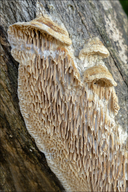|
|
click photo for larger file

Antrodia albida
No Name
|
Photographer: Dr. Amadej Trnkoczy
ID: 0000 0000 1222 1162 (2022-12-22)Copyright © 2022 Dr. Amadej Trnkoczy
|
|
INFORMATION PROVIDED WITH THE PHOTO
|
date of photo Nov 4, 2022
latitude 46.35877 longitude 13.70334
View on Google Maps.
location
Lower Trenta valley between villages Soča and Trenta, next to the trail from farmhouse Skokar, Trenta 2 to the Matevž's bridge (Trenta 1) on river Soča; East Julian Alps (Posočje, Slovenia)family
Fomitopsidaceae
notes Slo.: belkasta trhlica - syn.: Agaricus serpens (Fr.) E.H.L. Krause, Coriolellus serpens (Fr.) Bondartsev, Daedalea serpens (Fr.) Fr., Trametes subcervina Bres., Trametes serpens subsp. albida (Fr.) Bourdot & Galzin - Habitat: broadleaved wood, Fagus sylvatica and Picea abies dominant trees; moderately inclined mountain slope, south aspect; calcareous, colluvial, skeletal ground; in shade; partly protected from direct rain by tree canopies¸ average precipitations ~ 3.000 mm/year, average temperature 7 - 9 deg C, elevation 555 m (1.820 feet), alpine phytogeographical region (M. Wraber, 1969). - Substratum: fallen, decaying, decorticated, thick branch of Fagus sylvatica. - Comments (pertain to pictures in the Flicks album Antrodia albida): Antrodia albida is a cosmopolitan species, not common and in some European countries a rare species. It causes brown root of broadleaved, dead wood. It is very variable in habit. Sometimes it grows effused reflexed and forms distinct pilei as in this find. In these cases, pores on vertical surfaces are elongated, almost lamellae or teeth like. When growing totally resupinate it looks quite differently with more or less regular, round to angular large pores. However, even if in the effused-reflexed form the pores at the edge of the fruit body are always almost round. This is an important trait for determination of the species. Pilei are small, not much wider than a few cm at maximum, however in resupinate and effused-reflexed forms it can be 50 cm long and 10 cm wide. - Sporocarp dimensions: effuse-reflex form up to 37 cm long and up to 8 cm wide; pilei dimension up to 22 mm wide and 6 mm from the substratum; taste mild, mushroomy; smell indistinctive; flesh firm, leathery, firmly appressed to the substratum, almost impossible to separate both; SP none (invisible). Spores hard to find (may be not representative), smooth of variable size. Dimensions: (8) 8.3 - 11.4 (18) × (4.2) 4.4 - 6.1 (8.4) µm; Q = (1.5) 1.8 - 2.1; N = 11; Me = 10.5 × 5.4 µm; Qe = 1.9. - Ref.: (1) L. Ryvarden, I. Melo, Poroid fungi of Europe, Synopsis Fungorum 31., Fungiflora (2014), p 64. (2) L. Ryvarden, R.L. Gilbertson, European Polypores, part 1., Synopsis Fungorum 7., Fungiflora A/S (1993), p 112. SP 10-14/3.5-5 (3) A. Bernicchia, Polyporaceaes l., Fungi Europaei, Vol. 10., Edizioni Candusso (2005), p 94. SP 8-12/3.5-4.5 (4) http://aphyllopower.blogspot.com/2007/08/antrodia-albida-weiliche.html (accessed Dec. 21. 2022) (5) https://www.123pilze.de/DreamHC/Download/WeisseBraunfaeuletramete.htm (accessed Dec. 21. 2022), SP 13-15 x 5-7 µm (6) T. Lӕssøe, J.H. Petersen, Fungi of temperate Europe, Vol. 2., Princeton University Press (2019), p 897, SP 10-13/5-7. (7) G.J. Krieglsteiner (Hrsg.), Die Grosspilze Baden-Württembergs, Band 1., Ulmer (2000), p 477.camera Sony ILCE6000 / Carl Zeiss Vario-Tessar E 16-70 mm/f4
contributor's ID # Bot_1496/2022_DSC9331 photo category: Fungi - fungi
|
MORE INFORMATION ABOUT THIS FUNGUS
|
| common names
No Name (photographer)
View all photos in CalPhotos of Antrodia albida Check Google Images for Antrodia albida |
|
The photographer's identification Antrodia albida has not been reviewed. Click here to review or comment on the identification. |
|
Using this photo The thumbnail photo (128x192 pixels) on this page may be freely used for personal or academic purposes without prior permission under the Fair Use provisions of US copyright law as long as the photo is clearly credited with © 2022 Dr. Amadej Trnkoczy.
For other uses, or if you have questions, contact Dr. Amadej Trnkoczy amadej.trnkoczy[AT]siol.net. (Replace the [AT] with the @ symbol before sending an email.) |
|
|
